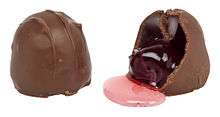Chocolate
Chocolate is a preparation of roasted and ground cacao seeds that is made in the form of a liquid, paste, or in a block, which may also be used as a flavoring ingredient in other foods. The earliest signs of use are associated with Olmec sites (within what would become Mexico’s post-colonial territory) suggesting consumption of chocolate beverages, dating from 19 centuries BCE.[1][2] The majority of Mesoamerican people made chocolate beverages, including the Maya and Aztecs.[3] The word chocolate is derived from the Spanish word chocolate, deriving in turn from the Classical Nahuatl word xocolātl.[4]
.jpg) Chocolate most commonly comes in dark, milk, and white varieties. | |
| Main ingredients | Chocolate liquor, cocoa butter for white chocolate, often with added sugar |
|---|---|
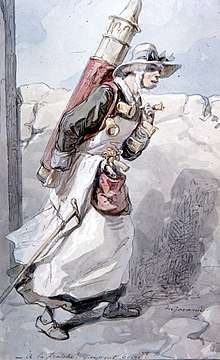
The seeds of the cacao tree have an intense bitter taste and must be fermented to develop the flavor. After fermentation, the beans are dried, cleaned, and roasted. The shell is removed to produce cacao nibs, which are then ground to cocoa mass, unadulterated chocolate in rough form. Once the cocoa mass is liquefied by heating, it is called chocolate liquor. The liquor may also be cooled and processed into its two components: cocoa solids and cocoa butter. Baking chocolate, also called bitter chocolate, contains cocoa solids and cocoa butter in varying proportions, without any added sugar. Powdered baking cocoa, which contains more fiber than cocoa butter, can be processed with alkali to produce dutch cocoa. Much of the chocolate consumed today is in the form of sweet chocolate, a combination of cocoa solids, cocoa butter or added vegetable oils, and sugar. Milk chocolate is sweet chocolate that additionally contains milk powder or condensed milk. White chocolate contains cocoa butter, sugar, and milk, but no cocoa solids.
Chocolate is one of the most popular food types and flavors in the world, and many foodstuffs involving chocolate exist, particularly desserts, including cakes, pudding, mousse, chocolate brownies, and chocolate chip cookies. Many candies are filled with or coated with sweetened chocolate. Chocolate bars, either made of solid chocolate or other ingredients coated in chocolate, are eaten as snacks. Gifts of chocolate molded into different shapes (such as eggs, hearts, coins) are traditional on certain Western holidays, including Christmas, Easter, Valentine's Day, and Hanukkah. Chocolate is also used in cold and hot beverages, such as chocolate milk and hot chocolate, and in some alcoholic drinks, such as creme de cacao.
Although cocoa originated in the Americas, West African countries, particularly Côte d'Ivoire and Ghana, are the leading producers of cocoa in the 21st century, accounting for some 60% of the world cocoa supply.
With some two million children involved in the farming of cocoa in West Africa, child slavery and trafficking were major concerns in 2018.[5][6] However, international attempts to improve conditions for children were failing because of persistent poverty, absence of schools, increasing world cocoa demand, more intensive farming of cocoa, and continued exploitation of child labor.[5]
History
Mesoamerican usage
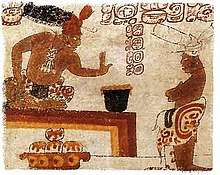
Chocolate has been prepared as a drink for nearly all of its history. For example, one vessel found at an Olmec archaeological site on the Gulf Coast of Veracruz, Mexico, dates chocolate's preparation by pre-Olmec peoples as early as 1750 BC.[7] On the Pacific coast of Chiapas, Mexico, a Mokaya archaeological site provides evidence of cacao beverages dating even earlier, to 1900 BC.[8][7] The residues and the kind of vessel in which they were found indicate the initial use of cacao was not simply as a beverage, but the white pulp around the cacao beans was likely used as a source of fermentable sugars for an alcoholic drink.[9]
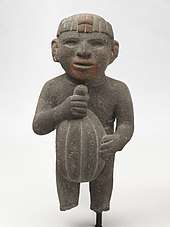
An early Classic-period (460–480 AD) Mayan tomb from the site in Rio Azul had vessels with the Maya glyph for cacao on them with residue of a chocolate drink, suggests the Maya were drinking chocolate around 400 AD.[10] Documents in Maya hieroglyphs stated chocolate was used for ceremonial purposes, in addition to everyday life.[11] The Maya grew cacao trees in their backyards,[12] and used the cacao seeds the trees produced to make a frothy, bitter drink.[13]
By the 15th century, the Aztecs gained control of a large part of Mesoamerica and adopted cacao into their culture. They associated chocolate with Quetzalcoatl, who, according to one legend, was cast away by the other gods for sharing chocolate with humans,[14] and identified its extrication from the pod with the removal of the human heart in sacrifice.[15] In contrast to the Maya, who liked their chocolate warm, the Aztecs drank it cold, seasoning it with a broad variety of additives, including the petals of the Cymbopetalum penduliflorum tree, chile pepper, allspice, vanilla, and honey.
The Aztecs were unable to grow cacao themselves, as their home in the Mexican highlands was unsuitable for it, so chocolate was a luxury imported into the empire.[14] Those who lived in areas ruled by the Aztecs were required to offer cacao seeds in payment of the tax they deemed "tribute".[14] Cocoa beans were often used as currency.[16] For example, the Aztecs used a system in which one turkey cost 100 cacao beans and one fresh avocado was worth three beans.[17]
The Maya and Aztecs associated cacao with human sacrifice, and chocolate drinks specifically with sacrificial human blood.[18][19] The Spanish royal chronicler Gonzalo Fernández de Oviedo described a chocolate drink he had seen in Nicaragua in 1528, mixed with achiote: "because those people are fond of drinking human blood, to make this beverage seem like blood, they add a little achiote, so that it then turns red. ... and part of that foam is left on the lips and around the mouth, and when it is red for having achiote, it seems a horrific thing, because it seems like blood itself."[19]
European adaptation
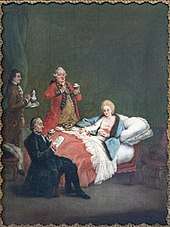
Until the 16th century, no European had ever heard of the popular drink from the Central American peoples.[14] Christopher Columbus and his son Ferdinand encountered the cacao bean on Columbus's fourth mission to the Americas on 15 August 1502, when he and his crew seized a large native canoe that proved to contain cacao beans among other goods for trade.[20] Spanish conquistador Hernán Cortés may have been the first European to encounter it, as the frothy drink was part of the after-dinner routine of Montezuma.[10][21] Jose de Acosta, a Spanish Jesuit missionary who lived in Peru and then Mexico in the later 16th century, wrote of its growing influence on the Spaniards:
Loathsome to such as are not acquainted with it, having a scum or froth that is very unpleasant to taste. Yet it is a drink very much esteemed among the Indians, where with they feast noble men who pass through their country. The Spaniards, both men and women, that are accustomed to the country, are very greedy of this Chocolaté. They say they make diverse sorts of it, some hot, some cold, and some temperate, and put therein much of that 'chili'; yea, they make paste thereof, the which they say is good for the stomach and against the catarrh.[22]
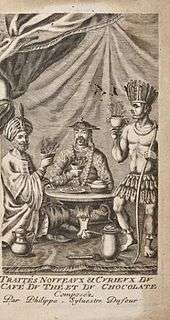
While Columbus had taken cacao beans with him back to Spain,[20] chocolate made no impact until Spanish friars introduced it to the Spanish court.[14] After the Spanish conquest of the Aztecs, chocolate was imported to Europe. There, it quickly became a court favorite. It was still served as a beverage, but the Spanish added sugar, as well as honey (the original sweetener used by the Aztecs for chocolate), to counteract the natural bitterness.[23] Vanilla, another indigenous American introduction, was also a popular additive, with pepper and other spices sometimes used to give the illusion of a more potent vanilla flavor. Unfortunately, these spices had the tendency to unsettle the European constitution; the Encyclopédie states, "The pleasant scent and sublime taste it imparts to chocolate have made it highly recommended; but a long experience having shown that it could potentially upset one's stomach", which is why chocolate without vanilla was sometimes referred to as "healthy chocolate".[24] By 1602, chocolate had made its way from Spain to Austria.[25] By 1662, Pope Alexander VII had declared that religious fasts were not broken by consuming chocolate drinks. Within about a hundred years, chocolate established a foothold throughout Europe.[14]
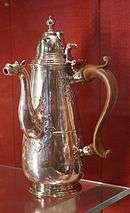
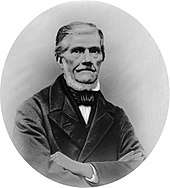
The new craze for chocolate brought with it a thriving slave market, as between the early 1600s and late 1800s, the laborious and slow processing of the cacao bean was manual.[14] Cacao plantations spread, as the English, Dutch, and French colonized and planted. With the depletion of Mesoamerican workers, largely to disease, cacao production was often the work of poor wage laborers and African slaves. Wind-powered and horse-drawn mills were used to speed production, augmenting human labor. Heating the working areas of the table-mill, an innovation that emerged in France in 1732, also assisted in extraction.[26]
New processes that sped the production of chocolate emerged early in the Industrial Revolution. In 1815, Dutch chemist Coenraad van Houten introduced alkaline salts to chocolate, which reduced its bitterness.[14] A few years thereafter, in 1828, he created a press to remove about half the natural fat (cocoa butter or cacao butter) from chocolate liquor, which made chocolate both cheaper to produce and more consistent in quality. This innovation introduced the modern era of chocolate.[20]
Known as "Dutch cocoa", this machine-pressed chocolate was instrumental in the transformation of chocolate to its solid form when, in 1847, English chocolatier Joseph Fry discovered a way to make chocolate moldable when he mixed the ingredients of cocoa powder and sugar with melted cocoa butter.[23] Subsequently, his chocolate factory, Fry's of Bristol, England, began mass-producing chocolate bars, Fry's Chocolate Cream, launched in 1866, and they became very popular.[27] Milk had sometimes been used as an addition to chocolate beverages since the mid-17th century, but in 1875 Swiss chocolatier Daniel Peter invented milk chocolate by mixing a powdered milk developed by Henri Nestlé with the liquor.[14][20] In 1879, the texture and taste of chocolate was further improved when Rudolphe Lindt invented the conching machine.[28]
Besides Nestlé, a number of notable chocolate companies had their start in the late 19th and early 20th centuries. Rowntree's of York set up and began producing chocolate in 1862, after buying out the Tuke family business. Cadbury was manufacturing boxed chocolates in England by 1868.[14] Manufacturing their first Easter egg in 1875, Cadbury created the modern chocolate Easter egg after developing a pure cocoa butter that could easily be moulded into smooth shapes.[29] In 1893, Milton S. Hershey purchased chocolate processing equipment at the World's Columbian Exposition in Chicago, and soon began the career of Hershey's chocolates with chocolate-coated caramels.
Introduction to the United States
The Baker Chocolate Company, famous for producing Baker's Chocolate, is the oldest producer of chocolate in the United States. In 1765 Dr. James Baker and John Hannon founded the company, which operated out of the Dorchester Lower Mills neighborhood in Boston. Using cocoa beans they’d brought back from the West Indies, the pair built their chocolate empire from the ground up – an empire still going strong today.[30][31]
White chocolate was first introduced to the U.S. in 1946 by Frederick E. Hebert of Hebert Candies in Shrewsbury, Massachusetts, near Boston, after he had tasted "white coat" candies while traveling in Europe.[32][31]
Etymology
.png)
Cacao, pronounced by the Olmecs as kakawa,[1] dates to 1000 BC or earlier.[1] The word "chocolate" entered the English language from Spanish in about 1600.[33] The word entered Spanish from the word xocolātl in Nahuatl, the language of the Aztecs. The origin of the Nahuatl word is uncertain, as it does not appear in any early Nahuatl source, where the word for chocolate drink is cacahuatl, "cacao water". It is possible that the Spaniards coined the word (perhaps in order to avoid caca, a vulgar Spanish word for "faeces") by combining the Yucatec Mayan word chocol, "hot", with the Nahuatl word atl, "water".[34] Another proposed etymology derives it from the word chicolatl, meaning "beaten drink", which may derive from the word for the frothing stick, chicoli.[35] The term "chocolatier", for a chocolate confection maker, is attested from 1888.[36]
Types
Several types of chocolate can be distinguished. Pure, unsweetened chocolate, often called "baking chocolate", contains primarily cocoa solids and cocoa butter in varying proportions. Much of the chocolate consumed today is in the form of sweet chocolate, which combines chocolate with sugar.
Milk
Milk chocolate is sweet chocolate that also contains milk powder or condensed milk. In the UK and Ireland, milk chocolate must contain a minimum of 20% total dry cocoa solids; in the rest of the European Union, the minimum is 25%.[37]
White
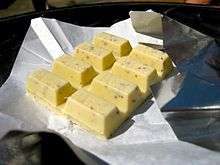
White chocolate, although similar in texture to that of milk and dark chocolate, does not contain any cocoa solids that impart a dark color. In 2002, the US Food and Drug Administration established a standard for white chocolate as the "common or usual name of products made from cacao fat (i.e., cocoa butter), milk solids, nutritive carbohydrate sweeteners, and other safe and suitable ingredients, but containing no nonfat cacao solids".[38]
Dark
Dark chocolate is produced by adding fat and sugar to the cacao mixture. The U.S. Food and Drug Administration calls this "sweet chocolate", and requires a 15% concentration of chocolate liquor. European rules specify a minimum of 35% cocoa solids.[37] A higher amount of cocoa solids indicates more bitterness. Semisweet chocolate is a dark chocolate with a low sugar content. Bittersweet chocolate is chocolate liquor to which some sugar (typically a third), more cocoa butter and vanilla are added.[39] It has less sugar and more liquor than semisweet chocolate, but the two are interchangeable in baking. It is also known to last for two years if stored properly. As of 2017, there is no high-quality evidence that dark chocolate affects blood pressure significantly or provides other health benefits.[40]
Unsweetened
Unsweetened chocolate is pure chocolate liquor, also known as bitter or baking chocolate. It is unadulterated chocolate: the pure, ground, roasted chocolate beans impart a strong, deep chocolate flavor. It is typically used in baking or other products to which sugar and other ingredients are added. Raw chocolate, often referred to as raw cacao, is always dark and a minimum of 75% cacao.
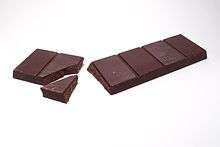
Poorly tempered or untempered chocolate may have whitish spots on the dark chocolate part, called chocolate bloom; it is an indication that sugar or fat has separated due to poor storage. It is not toxic and can be safely consumed.[41]
Production
Roughly two-thirds of the entire world's cocoa is produced in West Africa, with 43% sourced from Côte d'Ivoire,[42] where, as of 2007, child labor is a common practice to obtain the product.[43][44] According to the World Cocoa Foundation, in 2007 some 50 million people around the world depended on cocoa as a source of livelihood.[45] As of 2007 in the UK, most chocolatiers purchase their chocolate from them, to melt, mold and package to their own design.[46] According to the WCF's 2012 report, the Ivory Coast is the largest producer of cocoa in the world.[47] The two main jobs associated with creating chocolate candy are chocolate makers and chocolatiers. Chocolate makers use harvested cacao beans and other ingredients to produce couverture chocolate (covering). Chocolatiers use the finished couverture to make chocolate candies (bars, truffles, etc.).[48]
Production costs can be decreased by reducing cocoa solids content or by substituting cocoa butter with another fat. Cocoa growers object to allowing the resulting food to be called "chocolate", due to the risk of lower demand for their crops.[45]
Genome
The sequencing in 2010 of the genome of the cacao tree may allow yields to be improved.[49] Due to concerns about global warming effects on lowland climate in the narrow band of latitudes where cacao is grown (20 degrees north and south of the equator), the commercial company Mars, Incorporated and the University of California, Berkeley are conducting genomic research in 2017–18 to improve the survivability of cacao plants in hot climates.[50]
Cacao varieties
Chocolate is made from cocoa beans, the dried and fermented seeds of the cacao tree (Theobroma cacao), a small, 4–8 m tall (15–26 ft tall) evergreen tree native to the deep tropical region of the Americas. Recent genetic studies suggest the most common genotype of the plant originated in the Amazon basin and was gradually transported by humans throughout South and Central America. Early forms of another genotype have also been found in what is now Venezuela. The scientific name, Theobroma, means "food of the gods".[51] The fruit, called a cacao pod, is ovoid, 15–30 cm (6–12 in) long and 8–10 cm (3–4 in) wide, ripening yellow to orange, and weighing about 500 g (1.1 lb) when ripe.
Cacao trees are small, understory trees that need rich, well-drained soils. They naturally grow within 20° of either side of the equator because they need about 2000 mm of rainfall a year, and temperatures in the range of 21 to 32 °C (70 to 90 °F). Cacao trees cannot tolerate a temperature lower than 15 °C (59 °F).[52]
The three main varieties of cacao beans used in chocolate are criollo, forastero, and trinitario.
Criollo
Representing only 5% of all cocoa beans grown as of 2008,[53] criollo is the rarest and most expensive cocoa on the market, and is native to Central America, the Caribbean islands and the northern tier of South American states.[54] The genetic purity of cocoas sold today as criollo is disputed, as most populations have been exposed to the genetic influence of other varieties.
Criollos are particularly difficult to grow, as they are vulnerable to a variety of environmental threats and produce low yields of cocoa per tree. The flavor of criollo is described as delicate yet complex, low in classic chocolate flavor, but rich in "secondary" notes of long duration.[55]
Forastero
The most commonly grown bean is forastero,[53] a large group of wild and cultivated cacaos, most likely native to the Amazon basin. The African cocoa crop is entirely of the forastero variety. They are significantly hardier and of higher yield than criollo. The source of most chocolate marketed,[53] forastero cocoas are typically strong in classic "chocolate" flavor, but have a short duration and are unsupported by secondary flavors, producing "quite bland" chocolate.[53]
Trinitario
Trinitario is a natural hybrid of criollo and forastero. Trinitario originated in Trinidad after an introduction of forastero to the local criollo crop. Nearly all cacao produced over the past five decades is of the forastero or lower-grade trinitario varieties.[56]
Processing
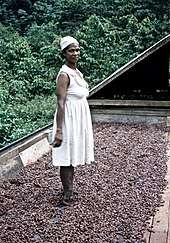
Cacao pods are harvested by cutting them from the tree using a machete, or by knocking them off the tree using a stick. The beans with their surrounding pulp are removed from the pods and placed in piles or bins, allowing access to micro-organisms so fermentation of the pectin-containing material can begin. Yeasts produce ethanol, lactic acid bacteria produce lactic acid, and acetic acid bacteria produce acetic acid. The fermentation process, which takes up to seven days, also produces several flavor precursors, eventually resulting in the familiar chocolate taste.[57]
It is important to harvest the pods when they are fully ripe, because if the pod is unripe, the beans will have a low cocoa butter content, or sugars in the white pulp will be insufficient for fermentation, resulting in a weak flavor. After fermentation, the beans must be quickly dried to prevent mold growth. Climate and weather permitting, this is done by spreading the beans out in the sun from five to seven days.[58]
The dried beans are then transported to a chocolate manufacturing facility. The beans are cleaned (removing twigs, stones, and other debris), roasted, and graded. Next, the shell of each bean is removed to extract the nib. Finally, the nibs are ground and liquefied, resulting in pure chocolate in fluid form: chocolate liquor.[59] The liquor can be further processed into two components: cocoa solids and cocoa butter.[60]
Blending
Chocolate liquor is blended with the cocoa butter in varying quantities to make different types of chocolate or couvertures. The basic blends of ingredients for the various types of chocolate (in order of highest quantity of cocoa liquor first), are:
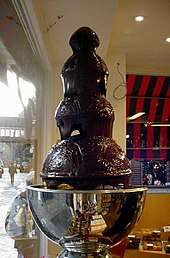
- Dark chocolate: sugar, cocoa butter, cocoa liquor, and (sometimes) vanilla
- Milk chocolate: sugar, cocoa butter, cocoa liquor, milk or milk powder, and vanilla
- White chocolate: sugar, cocoa butter, milk or milk powder, and vanilla
Usually, an emulsifying agent, such as soy lecithin, is added, though a few manufacturers prefer to exclude this ingredient for purity reasons and to remain GMO-free, sometimes at the cost of a perfectly smooth texture. Some manufacturers are now using PGPR, an artificial emulsifier derived from castor oil that allows them to reduce the amount of cocoa butter while maintaining the same mouthfeel.
The texture is also heavily influenced by processing, specifically conching (see below). The more expensive chocolate tends to be processed longer and thus have a smoother texture and mouthfeel, regardless of whether emulsifying agents are added.
Different manufacturers develop their own "signature" blends based on the above formulas, but varying proportions of the different constituents are used. The finest, plain dark chocolate couvertures contain at least 70% cocoa (both solids and butter), whereas milk chocolate usually contains up to 50%. High-quality white chocolate couvertures contain only about 35% cocoa butter.
Producers of high-quality, small-batch chocolate argue that mass production produces bad-quality chocolate.[53] Some mass-produced chocolate contains much less cocoa (as low as 7% in many cases), and fats other than cocoa butter. Vegetable oils and artificial vanilla flavor are often used in cheaper chocolate to mask poorly fermented and/or roasted beans.[53]
In 2007, the Chocolate Manufacturers Association in the United States, whose members include Hershey, Nestlé, and Archer Daniels Midland, lobbied the Food and Drug Administration (FDA) to change the legal definition of chocolate to let them substitute partially hydrogenated vegetable oils for cocoa butter, in addition to using artificial sweeteners and milk substitutes.[61] Currently, the FDA does not allow a product to be referred to as "chocolate" if the product contains any of these ingredients.[62][63]
In the EU a product can be sold as chocolate if it contains up to 5% vegetable oil, and must be labelled as "family milk chocolate" rather than "milk chocolate" if it contains 20% milk.[64]
According to Canadian Food and Drug Regulations,[65] a "chocolate product" is a food product that is sourced from at least one "cocoa product" and contains at least one of the following: "chocolate, bittersweet chocolate, semi-sweet chocolate, dark chocolate, sweet chocolate, milk chocolate, or white chocolate". A "cocoa product" is defined as a food product that is sourced from cocoa beans and contains "cocoa nibs, cocoa liquor, cocoa mass, unsweetened chocolate, bitter chocolate, chocolate liquor, cocoa, low-fat cocoa, cocoa powder, or low-fat cocoa powder".
Conching
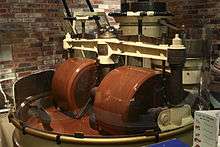
The penultimate process is called conching. A conche is a container filled with metal beads, which act as grinders. The refined and blended chocolate mass is kept in a liquid state by frictional heat. Chocolate prior to conching has an uneven and gritty texture. The conching process produces cocoa and sugar particles smaller than the tongue can detect, hence the smooth feel in the mouth. The length of the conching process determines the final smoothness and quality of the chocolate. High-quality chocolate is conched for about 72 hours, and lesser grades about four to six hours. After the process is complete, the chocolate mass is stored in tanks heated to about 45 to 50 °C (113 to 122 °F) until final processing.[66]
Tempering
The final process is called tempering. Uncontrolled crystallization of cocoa butter typically results in crystals of varying size, some or all large enough to be clearly seen with the naked eye. This causes the surface of the chocolate to appear mottled and matte, and causes the chocolate to crumble rather than snap when broken.[67][68] The uniform sheen and crisp bite of properly processed chocolate are the result of consistently small cocoa butter crystals produced by the tempering process.
The fats in cocoa butter can crystallize in six different forms (polymorphous crystallization).[67][69] The primary purpose of tempering is to assure that only the best form is present. The six different crystal forms have different properties.
| Crystal | Melting temp. | Notes |
|---|---|---|
| I | 17 °C (63 °F) | Soft, crumbly, melts too easily |
| II | 21 °C (70 °F) | Soft, crumbly, melts too easily |
| III | 26 °C (79 °F) | Firm, poor snap, melts too easily |
| IV | 28 °C (82 °F) | Firm, good snap, melts too easily |
| V | 34 °C (93 °F) | Glossy, firm, best snap, melts near body temperature (37 °C) |
| VI | 36 °C (97 °F) | Hard, takes weeks to form |

As a solid piece of chocolate, the cocoa butter fat particles are in a crystalline rigid structure that gives the chocolate its solid appearance. Once heated, the crystals of the polymorphic cocoa butter are able to break apart from the rigid structure and allow the chocolate to obtain a more fluid consistency as the temperature increases – the melting process. When the heat is removed, the cocoa butter crystals become rigid again and come closer together, allowing the chocolate to solidify.[70]
The temperature in which the crystals obtain enough energy to break apart from their rigid conformation would depend on the milk fat content in the chocolate and the shape of the fat molecules, as well as the form of the cocoa butter fat. Chocolate with a higher fat content will melt at a lower temperature.[71]
Making chocolate considered "good" is about forming as many type V crystals as possible. This provides the best appearance and texture and creates the most stable crystals, so the texture and appearance will not degrade over time. To accomplish this, the temperature is carefully manipulated during the crystallization.
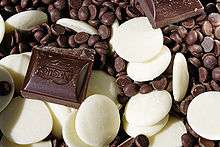
Generally, the chocolate is first heated to 45 °C (113 °F) to melt all six forms of crystals.[67][69] Next, the chocolate is cooled to about 27 °C (81 °F), which will allow crystal types IV and V to form. At this temperature, the chocolate is agitated to create many small crystal "seeds" which will serve as nuclei to create small crystals in the chocolate. The chocolate is then heated to about 31 °C (88 °F) to eliminate any type IV crystals, leaving just type V. After this point, any excessive heating of the chocolate will destroy the temper and this process will have to be repeated. Other methods of chocolate tempering are used as well. The most common variant is introducing already tempered, solid "seed" chocolate. The temper of chocolate can be measured with a chocolate temper meter to ensure accuracy and consistency. A sample cup is filled with the chocolate and placed in the unit which then displays or prints the results.
Two classic ways of manually tempering chocolate are:
- Working the molten chocolate on a heat-absorbing surface, such as a stone slab, until thickening indicates the presence of sufficient crystal "seeds"; the chocolate is then gently warmed to working temperature.
- Stirring solid chocolate into molten chocolate to "inoculate" the liquid chocolate with crystals (this method uses the already formed crystals of the solid chocolate to "seed" the molten chocolate).
Chocolate tempering machines (or temperers) with computer controls can be used for producing consistently tempered chocolate. In particular, continuous tempering machines are used in large volume applications. Various methods and apparatuses for continuous flow tempering have been described by Aasted, Sollich and Buhler, three manufacturers of commercial chocolate equipment, with a focus now on energy efficiency. In general, molten chocolate coming in at 40–50 °C is cooled in heat exchangers to crystallization temperates of about 26–30 °C, passed through a tempering column consisting of spinning plates to induce shear, then warmed slightly to re-melt undesirable crystal formations.[72][73]
Storage
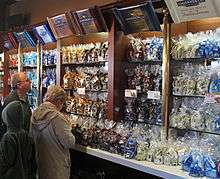
Chocolate is very sensitive to temperature and humidity. Ideal storage temperatures are between 15 and 17 °C (59 and 63 °F), with a relative humidity of less than 50%. If refrigerated or frozen without containment, chocolate can absorb enough moisture to cause a whitish discoloration, the result of fat or sugar crystals rising to the surface. Various types of "blooming" effects can occur if chocolate is stored or served improperly.[74]
Chocolate bloom is caused by storage temperature fluctuating or exceeding 24 °C (75 °F), while sugar bloom is caused by temperature below 15 °C (59 °F) or excess humidity. To distinguish between different types of bloom, one can rub the surface of the chocolate lightly, and if the bloom disappears, it is fat bloom. Moving chocolate between temperature extremes, can result in an oily texture. Although visually unappealing, chocolate suffering from bloom is safe for consumption and taste unaffected.[75][76][77] Bloom can be reversed by retempering the chocolate or using it for any use that requires melting the chocolate.[78]
Chocolate is generally stored away from other foods, as it can absorb different aromas. Ideally, chocolates are packed or wrapped, and placed in proper storage with the correct humidity and temperature. Additionally, chocolate is frequently stored in a dark place or protected from light by wrapping paper. The glossy shine, snap, aroma, texture, and taste of the chocolate can show the quality and if it was stored well.[79]
Composition
| Nutritional value per 100 g (3.5 oz) | |
|---|---|
| Energy | 2,240 kJ (540 kcal) |
59.4 | |
| Sugars | 51.5 |
| Dietary fiber | 3.4 g |
29.7 | |
7.6 | |
| Vitamins | Quantity %DV† |
| Vitamin A | 195 IU |
| Thiamine (B1) | 9% 0.1 mg |
| Riboflavin (B2) | 25% 0.3 mg |
| Niacin (B3) | 3% 0.4 mg |
| Vitamin B6 | 0% 0.0 mg |
| Folate (B9) | 3% 11 μg |
| Vitamin B12 | 29% 0.7 μg |
| Choline | 9% 46.1 mg |
| Vitamin C | 0% 0 mg |
| Vitamin E | 3% 0.5 mg |
| Vitamin K | 5% 5.7 μg |
| Minerals | Quantity %DV† |
| Calcium | 19% 189 mg |
| Iron | 18% 2.4 mg |
| Magnesium | 18% 63 mg |
| Manganese | 24% 0.5 mg |
| Phosphorus | 30% 208 mg |
| Potassium | 8% 372 mg |
| Selenium | 6% 4.5 μg |
| Sodium | 5% 79 mg |
| Zinc | 24% 2.3 mg |
| Other constituents | Quantity |
| Water | 1.5 g |
| Caffeine | 20 mg |
| Cholesterol | 23 mg |
| Theobromine | 205 mg |
| |
| †Percentages are roughly approximated using US recommendations for adults. Source: USDA Nutrient Database | |
Nutrition
A 100-gram serving of milk chocolate supplies 540 calories. It is 59% carbohydrates (52% as sugar and 3% as dietary fiber), 30% fat and 8% protein (table). Approximately 65% of the fat in milk chocolate is saturated, mainly palmitic acid and stearic acid, while the predominant unsaturated fat is oleic acid (table, see USDA reference for full report).
100-grams of milk chocolate is an excellent source (over 19% of the Daily Value, DV) of riboflavin, vitamin B12 and the dietary minerals, manganese, phosphorus and zinc. Chocolate is a good source (10–19% DV) of calcium, magnesium and iron.
Effects on health
Chocolate may be a factor for heartburn in some people because one of its constituents, theobromine, may affect the esophageal sphincter muscle in a way that permits stomach acids to enter the esophagus.[80] Theobromine poisoning is an overdosage reaction to the bitter alkaloid, which happens more frequently in domestic animals than humans. However, daily intake of 50–100 g cocoa (0.8–1.5 g theobromine) by humans has been associated with sweating, trembling and severe headache.[81] Chocolate contains alkaloids such as theobromine and phenethylamine, which have physiological effects in humans, but the presence of theobromine renders it toxic to some animals, such as dogs and cats.[82]
Chocolate and cocoa contain moderate to high amounts of oxalate,[83][84] which may increase someone's risk for kidney stones.[85] During cultivation and production, chocolate may absorb the heavy metal lead from the environment,[86] but the total amounts typically eaten are less than the tolerable daily limit for lead consumption, according to a World Health Organization report from 2010.[87] However, reports from 2014 indicate that "chocolate might be a significant source" of lead ingestion for children if consumption is high,[88][89] and "one 10 g cube of dark chocolate may contain as much as 20% of the daily lead oral limit."[88]
A few studies have documented allergic reactions from chocolate in children.[80] Other research has shown that dark chocolate can aggravate acne in men who are prone to it.[90] Research has also shown that consuming dark chocolate does not substantially affect blood pressure.[40] Chocolate and cocoa are under preliminary research to determine if consumption affects the risk of certain cardiovascular diseases[91] or cognitive abilities.[92]
A one-tablespoon (5 grams) serving of dry unsweetened cocoa powder has 12.1 mg of caffeine[93] and a 25-g single serving of dark chocolate has 22.4 mg of caffeine.[94] Although a single 7 oz. serving of coffee may contain 80–175 mg,[95] studies have shown psychoactive effects in caffeine doses as low as 9 mg,[96] and a dose as low as 12.5 mg was shown to have effects on cognitive performance.[97]
Excessive consumption of large quantities of any energy-rich food, such as chocolate, without a corresponding increase in activity to expend the associated calories, can cause weight gain and possibly lead to obesity.[80] Raw chocolate is high in cocoa butter, a fat which is removed during chocolate refining and then added back in varying proportions during the manufacturing process. Manufacturers may add other fats, sugars, and milk, all of which increase the caloric content of chocolate.[80]
Phytochemicals
Cocoa contains certain phytochemicals. Cocoa solids are a source of flavonoids[98] and alkaloids, such as theobromine, phenethylamine, and caffeine.[99]
Labeling
Some manufacturers provide the percentage of chocolate in a finished chocolate confection as a label quoting percentage of "cocoa" or "cacao". This refers to the combined percentage of both cocoa solids and cocoa butter in the bar, not just the percentage of cocoa solids.[100] The Belgian AMBAO certification mark indicates that no non-cocoa vegetable fats have been used in making the chocolate.[101][102]
Chocolates that are organic[103] or fair trade certified[104] carry labels accordingly.
In the United States, some large chocolate manufacturers lobbied the federal government to permit confections containing cheaper hydrogenated vegetable oil in place of cocoa butter to be sold as "chocolate". In June 2007, as a response to consumer concern after the proposed change, the FDA reiterated "Cacao fat, as one of the signature characteristics of the product, will remain a principal component of standardized chocolate."[105]
Industry
The chocolate industry is a steadily growing, $50 billion-a-year worldwide business centered on the sale and consumption of chocolate. It is prevalent throughout most of the world.[106] Europe accounts for 45% of the world's chocolate revenue[107] and the US$20 billion.[108] Big Chocolate is the grouping of major international chocolate companies in Europe and the U.S. The U.S. companies, such as Mars and Hershey's alone, generate $13 billion a year in chocolate sales and account for two-thirds of U.S. production.[109] Despite the expanding reach of the chocolate industry internationally, cocoa farmers and labourers in the Ivory Coast are unaware of the uses of the beans. The high cost of chocolate in the Ivory Coast also means that it is inaccessible to the majority of the population, who are unaware of what it tastes like.[110]
Manufacturers
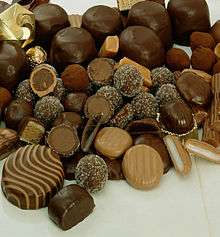
Chocolate manufacturers produce a range of products from chocolate bars to fudge. Large manufacturers of chocolate products include Cadbury (the world's largest confectionery manufacturer), Ferrero, Guylian, The Hershey Company, Lindt & Sprüngli, Mars, Incorporated, Milka, Neuhaus and Suchard.
Guylian is best known for its chocolate sea shells; Cadbury for its Dairy Milk and Creme Egg. The Hershey Company, the largest chocolate manufacturer in North America, produces the Hershey Bar and Hershey's Kisses.[111] Mars Incorporated, a large privately owned U.S. corporation, produces Mars Bar, Milky Way, M&M's, Twix, and Snickers. Lindt is known for its truffle balls and gold foil-wrapped Easter bunnies.
Food conglomerates Nestlé SA and Kraft Foods both have chocolate brands. Nestlé acquired Rowntree's in 1988 and now markets chocolates under their own brand, including Smarties (a chocolate candy) and Kit Kat (a chocolate bar); Kraft Foods through its 1990 acquisition of Jacobs Suchard, now owns Milka and Suchard. In February 2010, Kraft also acquired British-based Cadbury;[112] Fry's, Trebor Basset and the fair trade brand Green & Black's also belongs to the group.
Child labor in cocoa harvesting
The widespread use of children in cocoa production is controversial, not only for the concerns about child labor and exploitation, but also because up to 12,000 of the 200,000 children working in Côte d'Ivoire, the world's biggest producer of cocoa,[113] may be victims of trafficking or slavery.[114] Most attention on this subject has focused on West Africa, which collectively supplies 69 percent of the world's cocoa,[115] and Côte d'Ivoire in particular, which supplies 35 percent of the world's cocoa.[115] Thirty percent of children under age 15 in sub-Saharan Africa are child laborers, mostly in agricultural activities including cocoa farming.[116] Major chocolate producers, such as Nestlé, buy cocoa at commodities exchanges where Ivorian cocoa is mixed with other cocoa.[117]
In 2009, Salvation Army International Development (SAID) UK stated that 12,000 children have been trafficked on cocoa farms in the Ivory Coast of Africa, where half of the world's chocolate is made.[118] SAID UK states that it is these child slaves who are likely to be working in "harsh and abusive"[119] conditions for the production of chocolate,[118] and an increasing number of health-food[120] and anti-slavery[121] organisations are highlighting and campaigning against the use of trafficking in the chocolate industry.
As of 2017, approximately 2.1 million children in Ghana and Côte d'Ivoire were involved in farming cocoa, carrying heavy loads, clearing forests, and being exposed to pesticides.[6] According to Sona Ebai, the former secretary general of the Alliance of Cocoa Producing Countries: "I think child labor cannot be just the responsibility of industry to solve. I think it's the proverbial all-hands-on-deck: government, civil society, the private sector. And there, you really need leadership."[114] Reported in 2018, a 3-year pilot program – conducted by Nestlé with 26,000 farmers mostly located in Côte d'Ivoire – observed a 51% decrease in the number of children doing hazardous jobs in cocoa farming.[5] The US Department of Labor formed the Child Labor Cocoa Coordinating Group as a public-private partnership with the governments of Ghana and Côte d'Ivoire to address child labor practices in the cocoa industry.[122] The International Cocoa Initiative involving major cocoa manufacturers established the Child Labor Monitoring and Remediation System intended to monitor thousands of farms in Ghana and Côte d'Ivoire for child labor conditions,[5][6] but the program reached less than 20% of the child laborers.[123] Despite these efforts, goals to reduce child labor in West Africa by 70% before 2020 are frustrated by persistent poverty, absence of schools, expansion of cocoa farmland, and increased demand for cocoa.[5][124]
In April 2018, the Cocoa Barometer report stated: "Not a single company or government is anywhere near reaching the sectorwide objective of the elimination of child labour, and not even near their commitments of a 70% reduction of child labour by 2020".[124]
Fair trade
In the 2000s, some chocolate producers began to engage in fair trade initiatives, to address concerns about the marginalization of cocoa laborers in developing countries. Traditionally, Africa and other developing countries received low prices for their exported commodities such as cocoa, which caused poverty to abound. Fair trade seeks to establish a system of direct trade from developing countries to counteract this unfair system.[125] One solution for fair labor practices is for farmers to become part of an Agricultural cooperative. Cooperatives pay farmers a fair price for their cocoa so farmers have enough money for food, clothes, and school fees.[126] One of the main tenets of fair trade is that farmers receive a fair price, but this does not mean that the larger amount of money paid for fair trade cocoa goes directly to the farmers. The effectiveness of fair trade has been questioned. In a 2014 article, The Economist stated that workers on fair trade farms have a lower standard of living than on similar farms outside the fair trade system.[127]
Usage and consumption
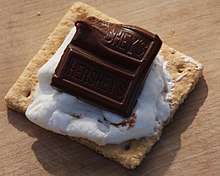
Bars
Chocolate is sold in chocolate bars, which come in dark chocolate, milk chocolate and white chocolate varieties. Some bars that are mostly chocolate have other ingredients blended into the chocolate, such as nuts, raisins or crisped rice. Chocolate is used as an ingredient in a huge variety of bars, which typically contain various confectionary ingredients (e.g., nougat, wafers, caramel, nuts, etc.) which are coated in chocolate.
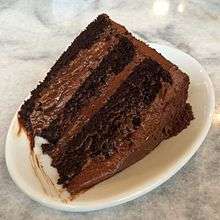
Coating and filling
Chocolate is used as a flavouring product in many desserts, such as chocolate cakes, chocolate brownies, chocolate mousse and chocolate chip cookies. Numerous types of candy and snacks contain chocolate, either as a filling (e.g., M&M's) or as a coating (e.g., chocolate-coated raisins or chocolate-coated peanuts).
Beverages
Some non-alcoholic beverages contain chocolate, such as chocolate milk, hot chocolate and chocolate milkshakes. Some alcoholic liqueurs are flavoured with chocolate, such as chocolate liqueur and creme de cacao. Chocolate is a popular flavour of ice cream and pudding, and chocolate sauce is a commonly added as a topping on ice cream sundaes. The caffè mocha is an espresso beverage containing chocolate.
See also
- Candida krusei
- Candy making
- Children in cocoa production
- Chocolataire
- Chocolate almonds
- Chocolate chip
- Cuestión moral: si el chocolate quebranta el ayuno eclesiástico
- List of chocolate-covered foods
- List of chocolate beverages
- List of chocolate companies
- The chocolate game
- Theobroma cacao, the cocoa/chocolate plant
- United States military chocolate
References
- Powis, Terry G.; Cyphers, Ann; Gaikwad, Nilesh W.; Grivetti, Louis; Cheong, Kong (24 May 2011). "Cacao use and the San Lorenzo Olmec". Proceedings of the National Academy of Sciences. 108 (21): 8595–8600. Bibcode:2011PNAS..108.8595P. doi:10.1073/pnas.1100620108. ISSN 0027-8424. PMC 3102397. PMID 21555564.
- "Consumían olmecas chocolate hace 3000 años". El Universal. Mexico City. 29 July 2008.
- "Chocolate: A Mesoamerican Luxury 1200–1521 – Obtaining Cacao". Field Museum. Retrieved 23 November 2011.
- "The American Heritage Dictionary". Archived from the original on 11 October 2008. Retrieved 9 May 2009.
- Oliver Balch (20 June 2018). "Child labour: the true cost of chocolate production". Raconteur. Retrieved 7 January 2019.
- Kieran Guilbert (12 June 2017). "Falling cocoa prices threaten child labor spike in Ghana, Ivory Coast". Reuters. Retrieved 7 January 2019.
- Terry G. Powis; W. Jeffrey Hurst; María del Carmen Rodríguez; Ponciano Ortíz C.; Michael Blake; David Cheetham; Michael D. Coe; John G. Hodgson (December 2007). "Oldest chocolate in the New World". Antiquity. 81 (314). ISSN 0003-598X. Archived from the original on 28 June 2011. Retrieved 15 February 2011.
- Watson, Traci (22 January 2013). "Earliest Evidence of Chocolate in North America". Science. Archived from the original on 6 March 2014. Retrieved 3 March 2014.
- "New Chemical Analyses Take Confirmation Back 500 Years and Reveal that the Impetus for Cacao Cultivation was an Alcoholic Beverage". Penn Museum. 2007. Archived from the original on 2 December 2007. Retrieved 13 November 2007.
- Burleigh, Robert (2002). Chocolate: Riches from the Rainforest. Harry N. Abrams, Ins., Publishers. ISBN 978-0-8109-5734-3.
- "Chocolate: A Mesoamerican Luxury 250–900 C.E. (A.D.) – Using Chocolate". Field Museum. Retrieved 23 November 2011.
- "Chocolate: A Mesoamerican Luxury 250–900 C.E. (A.D.) – Obtaining Cacao". Field Museum. Retrieved 2 June 2008.
- "Chocolate: A Mesoamerican Luxury 250–900 C.E. (A.D.) – Making Chocolate". Field Museum. Retrieved 2 June 2008.
- "History of Chocolate". Field Museum. Retrieved 3 March 2014.
- "Aztecs and Cacao: the bittersweet past of chocolate". The Daily Telegraph. 15 September 2009. Archived from the original on 18 April 2014. Retrieved 8 March 2014.
- Peniche Rivero, Piedad (1990). "When cocoa was used as currency – pre-Columbian America – The Fortunes of Money". UNESCO Courier. Archived from the original on 27 May 2012. Retrieved 26 June 2008.
- Buford, Bill (29 October 2007). "Notes of a Gastronome: Extreme Chocolate". The New Yorker. Archived from the original on 16 June 2008. Retrieved 17 May 2008.
- Coe & Coe (2013), p. 46.
- Chinchilla Mazariegos (2016), p. 361.
- Spadaccini, Jim. "The Sweet Lure of Chocolate". Exploratorium. Archived from the original on 14 March 2014. Retrieved 3 March 2014.
- Solís y Ribadeneyra, Antonio de (1685). "Book III Chapter XV". The History of the Conquest of Mexico by the Spaniards, done into English by Thomas Townsend. Translated by Thomas Townsend. London. pp. 336–38.
- "History of Chocolate" Archived 18 March 2017 at the Wayback Machine. sfu.ca.
- Bensen, Amanda (1 March 2008). "A Brief History of Chocolate". Smithsonian Magazine. Retrieved 3 March 2014.
- Diderot, Denis. "Chocolate." in The Encyclopedia of Diderot & d'Alembert Collaborative Translation Project. Translated by Colleen Oberc, Samantha Schaeffer, and Courtney Wilder. Ann Arbor: University of Michigan Library, 2015. Trans. of "Chocolat," Encyclopédie ou Dictionnaire raisonné des sciences, des arts et des métiers, vol. 3. Paris, 1753."
- Szogyi, Alex (1997). Chocolate: Food of the Gods. Greenwood Publishing Group. p. 199. ISBN 978-0-313-30506-1. Archived from the original on 5 February 2016.
- Wilson, Philip K.; Hurst, W. Jeffrey, eds. (2015). Chocolate and Health. Royal Society of Chemistry. p. 219. doi:10.1039/9781782622802. ISBN 978-1-84973-912-2.
- Mintz, Sidney (2015). The Oxford Companion to Sugar and Sweets. Oxford University Press. p. 157.
- Klein, Christopher (14 February 2014). "The Sweet History of Chocolate". History. Archived from the original on 8 March 2014. Retrieved 3 March 2014.
- "Amazing archive images show how Cadbury cracked Easter egg market". Birmingham Mail. Retrieved 21 May 2019.
- "Boston's chocolate history". Boston Globe. 27 July 2013.
- "Where did the first chocolate factory in the U.S. open?". Travel Trivia. 25 November 2019.
- Ann Trieger Kurland (26 June 2017). "Hebert Candies marks 100 years of yum". Boston Globe.
- "Chocolate". The American Heritage Dictionary. Archived from the original on 17 May 2008. Retrieved 9 May 2009.
- Coe & Coe (2013), pp. 121–123.
- Dakin, Karen; Wichmann, Søren (2000). "Cacao and Chocolate: A Uto-Aztecan perspective". Ancient Mesoamerica. 11 (1): 55–75. doi:10.1017/S0956536100111058. Retrieved 10 January 2018.
- Harper, Douglas. "Chocolate". Online Etymology Dictionary.
- "Directive 2000/36/EC of the European Parliament and of the Council of 23 June 2000 relating to cocoa and chocolate products intended for human consumption". Publications Office of the European Union. Retrieved 31 October 2010.
- "US Federal Register – White Chocolate; Establishment of a Standard of Identity". U.S. Food and Drug Administration. Archived from the original on 21 March 2008. Retrieved 1 June 2008.
- Matsko Hood, Karen Jean (2015). Chocolate Delights Cookbook: A Collection of Chocolate Recipes. Whispering Pine Press International, Inc.
- Ried, K; Fakler, P; Stocks, N. P (2017). "Effect of cocoa on blood pressure". Cochrane Database of Systematic Reviews. 4: CD008893. doi:10.1002/14651858.CD008893.pub3. PMC 6478304. PMID 28439881.
- Kinta, Yasuyoshi; Hartel, Richard W. (20 August 2009). "Bloom Formation on Poorly-Tempered Chocolate and Effects of Seed Addition" (PDF). Journal of the American Oil Chemists' Society. 87 (1): 19–27. doi:10.1007/s11746-009-1473-5. Archived (PDF) from the original on 19 September 2016. Retrieved 12 September 2016.
- Ariyoshi, Rita (2007). "The Rarest Chocolate in the World – Surprise: It's made in Hawai'i". Spirit of Aloha. Archived from the original on 18 October 2007. Retrieved 2 May 2007.
- Hawksley, Humphrey (13 June 2002). "Meeting the 'chocolate slaves'". BBC News. Archived from the original on 30 September 2009. Retrieved 22 January 2010.
- McKenzie, David and Swails, Brent (19 January 2012) Slavery in Cocoa fields: a horrible "normal" Archived 16 March 2016 at the Wayback Machine. CNN.
- Bridges, Andrew (7 August 2007). "Sides square off in chocolate fight". Pantagraph. Archived from the original on 12 April 2009. Retrieved 17 May 2008.
- Dillon, Sheila (23 December 2007). "The Food Programme" (RealAudio). BBC Radio 4. Archived from the original on 9 November 2014.
- "Cocoa Market Update (2012)" (PDF). World Cocoa Foundation. Archived from the original (PDF) on 6 June 2014. Retrieved 17 August 2014.
- "What's Noka Worth? An investigation in high-priced chocolate". Dallas Food. Archived from the original on 13 June 2007. Retrieved 31 December 2006.
- "Chocolate industry avoids collapse as genome published". BBC. 14 November 2010. Archived from the original on 15 November 2010. Retrieved 15 November 2010.
- Brodwin, Erin (31 December 2017). "Chocolate is on track to go extinct in 40 years". Business Insider, Inc. Retrieved 31 January 2018.
- "Cacao". Botanica.com. 1995–2008. Archived from the original on 14 May 2008. Retrieved 27 June 2008.
- "All About Chocolate: The Cacao Tree". Xocoatl. Archived from the original on 19 December 2007. Retrieved 20 December 2007.
- Kowalchuk, Kristine. "Cuckoo for Cocoa". Westworld Alberta. Archived from the original on 28 February 2008. Retrieved 1 February 2008.
- "Criollo Chocolate: Efficient Food of the Gods". MetaEfficient. Archived from the original on 28 August 2008. Retrieved 17 May 2008.
- "Sensational Chocolates: Discover the Intense Robust flavor of 100% 'Grand Cru' Chocolate". Sensational Chocolates. Archived from the original on 28 March 2008. Retrieved 17 May 2008.
- "What are the varieties of cocoa?". International Cocoa Organization. 21 July 1998. Archived from the original on 18 February 2006. Retrieved 27 June 2006.
- Schwan, R.; Wheals, A. (2004). "The Microbiology of Cocoa Fermentation and its Role in Chocolate Quality". Critical Reviews in Food Science and Nutrition. 44 (4): 205–221. doi:10.1080/10408690490464104. PMID 15462126.
- "Harvesting the seeds". Xocoatl. Archived from the original on 21 May 2008. Retrieved 20 May 2008.
- "Making Chocolate from Scratch" (PDF). Archived from the original (PDF) on 31 March 2010. Retrieved 2 August 2011.
- "At the chocolate factory". The Cocoa Tree. Archived from the original on 14 January 2007. Retrieved 20 May 2008.
- Bragg, Lynn (2007). "Letter to CMA from President" (PDF). Archived from the original (PDF) on 4 June 2007. Retrieved 8 June 2007.
- "Adopt Regulations of General Applicability to all Food Standards that would Permit, within Stated Boundaries, Deviations from the Requirements of the Individual Food Standards of Identity". U.S. Food and Drug Administration. Archived from the original on 22 May 2007. Retrieved 9 June 2007.
- "2007P-0085 Appendix C Changes Allowed to Modernize Food Standards While Retaining The Basic Nature and Essential Characteristics of Standardized Food" (PDF). U.S. Food and Drug Administration. Retrieved 9 June 2007.
- Sweet victory for UK chocolate Archived 3 August 2017 at the Wayback Machine BBC News (15 March 2000)
- "Division 4: Cocoa and Chocolate Products". Government of Canada: Food and Drug Regulations (C.R.C., c. 870). 13 June 2017. Archived from the original on 13 July 2017. Retrieved 20 July 2017.
- Zonis, Stephanie. "Conching: Crucial Step in Chocolate's Flavor and Texture?". Sally's Place. Archived from the original on 17 June 2008. Retrieved 20 May 2008.
- LaBau, Elizabeth. "How To Temper Chocolate". About.com. Archived from the original on 8 October 2008. Retrieved 20 May 2008.
- Afoakwa, Emmanuel Ohene; Paterson, Alistair; Fowler, Mark; Vieira, Joselio (November 2008). "Effects of tempering and fat crystallisation behaviour on microstructure, mechanical properties and appearance in dark chocolate systems". Journal of Food Engineering. 89 (2): 128–136. doi:10.1016/j.jfoodeng.2008.04.021.
- Loisel, C.; Keller, G.; Lecq, G.; Bourgaux, C.; Ollivon, M. (1998). "Phase Transitions and Polymorphism of Cocoa Butter". Journal of the American Oil Chemists' Society. 75 (4). pp.425–439, see Table 2 p. 426 for tempering temperatures. doi:10.1007/s11746-998-0245-y.
- National Confectioner's Association. "The Sweet Truth about Cocoa Butter" (PDF). Archived from the original (PDF) on 10 August 2013. Retrieved 23 April 2013.
- "Why Chocolate Melts and Jet Planes Don't" (PDF). The Royal Institution of Great Britain. Archived from the original (PDF) on 10 March 2020. Retrieved 24 April 2013.
- EP Granted 0289849, Helmut Sollich, "Process and apparatus for the continuous preparation of cacao butter or similar fat-containing masses to be processed", published 1988-11-09, assigned to Sollich KG
- EP Pending 2862449, Peter Braun, "Method and use of an apparatus for continuous tempering of chocolate mass comprising crystals", published 2015-04-22, assigned to Bühler AG
- DeMarco, E. (7 May 2015). "X-rays reveal how chocolate turns white". Science. doi:10.1126/science.aac4563. Archived from the original on 8 May 2015. Retrieved 8 May 2015.
- "Tips for Chocolate Care". Ghirardelli. Archived from the original on 6 February 2007. Retrieved 16 April 2007.
- Miller, Teresa. "Milkfat Fractions Help Beat Blooming Chocolate". College of Agricultural Life and Sciences, University of Wisconsin-Madison. Archived from the original on 9 June 2007. Retrieved 16 April 2007.
- "How to Store Chocolate". CocoaBella. Archived from the original on 8 February 2007. Retrieved 16 April 2007.
- Bau, Frederic, ed. (2011). Cooking With Chocolate: Essential Recipes and Techniques. Paris: Flammarion, S.A. p. 147. ISBN 978-2-08-020081-5.
- "Chocolate: Types (Unsweetened, Bittersweet, Semisweet, Milk), Selection, and Storage". Better Homes & Gardens. 9 June 2015. Retrieved 10 May 2018.
- Latif, R (March 2013). "Chocolate/cocoa and human health: a review". Neth J Med. 71 (2): 63–8. PMID 23462053.
- "3,7-Dimethylxanthine".
- Crosby, Janet Tobiassen. "Chocolate Toxicity". Veterinary Q & A. About.com. Archived from the original on 2 May 2008. Retrieved 20 May 2008.
- Schroder, Theresa; Vanhanen, Leo; Savage, Geoffrey P. (2011). "Oxalate content in commercially produced cocoa and dark chocolate". Journal of Food Composition and Analysis. 24 (7): 916–922. doi:10.1016/j.jfca.2011.03.008.
- Aremu, CY; Agiang, MA; Ayatse, JO (1995). "Nutrient and antinutrient profiles of raw and fermented cocoa beans". Plant Foods for Human Nutrition (Dordrecht, Netherlands). 48 (3): 217–23. doi:10.1007/bf01088443. PMID 8833428.
- "Kidney Stones: Overview from the Nephrology Department". Cleveland Clinic. Archived from the original on 5 July 2013.
- Rankin, Charley W.; Jerome O. Nriagu; Jugdeep K. Aggarwal; Toyin A. Arowolo; Kola Adebayo; A. Russell Flegal (October 2005). "Lead Contamination in Cocoa and Cocoa Products: Isotopic Evidence of Global Contamination". Environmental Health Perspectives. 113 (10): 1344–8. doi:10.1289/ehp.8009. PMC 1281277. PMID 16203244.
- "Lead Content of Soil, Plants, Foods, Air, and Chinese Herb Formulas". Archived from the original on 31 July 2010. Retrieved 7 August 2010.
- Yanus, Rinat Levi; Sela, Hagit; Borojovich, Eitan J.C.; Zakon, Yevgeni; Saphier, Magal; Nikolski, Andrey; Gutflais, Efi; Lorber, Avraham; Karpas, Zeev (2014). "Trace elements in cocoa solids and chocolate: An ICPMS study". Talanta. 119: 1–4. doi:10.1016/j.talanta.2013.10.048. PMID 24401377.
- Villa, Javier E. L.; Peixoto, Rafaella R. A.; Cadore, Solange (2014). "Cadmium and Lead in Chocolates Commercialized in Brazil". Journal of Agricultural and Food Chemistry. 62 (34): 8759–63. doi:10.1021/jf5026604. PMID 25123980.
- Vongraviopap, Saivaree; Asawanonda, Pravit (May 2016). "Dark chocolate exacerbates acne". International Journal of Dermatology. 55 (5): 587–591. doi:10.1111/ijd.13188. ISSN 1365-4632. PMID 26711092.
- Buitrago-Lopez, A.; Sanderson, J.; Johnson, L.; Warnakula, S.; Wood, A.; Di Angelantonio, E.; Franco, O. H. (2011). "Chocolate consumption and cardiometabolic disorders: Systematic review and meta-analysis". BMJ. 343: d4488. doi:10.1136/bmj.d4488. PMC 3163382. PMID 21875885.
- Nurk, Eha; Refsum, H.; Drevon, C. A.; Tell, G. S.; Nygaard, H. A.; Engedal, K.; Smith, A. D.; Vollset, SE; Refsum, H (2009). "Intake of Flavonoid-Rich Wine, Tea, and Chocolate by Elderly Men and Women Is Associated with Better Cognitive Test Performance". Journal of Nutrition. 139 (1): 120–127. doi:10.3945/jn.108.095182. PMID 19056649.
- "Cocoa, dry powder, unsweetened Nutrition Facts & Calories". nutritiondata.self.com. Retrieved 24 August 2018.
- "Candies, chocolate, dark, 70–85% cacao solids Nutrition Facts & Calories". nutritiondata.self.com. Retrieved 24 August 2018.
- Bunker, M. L.; McWilliams, M. (1979). "Caffeine content of common beverages". Journal of the American Dietetic Association. 74 (1): 28–32. PMID 762339.
- "Effects of Low Doses of Caffeine on Mood, Physiology and Mental Function - Full Text View - ClinicalTrials.gov". Retrieved 24 August 2018.
- Smit, H. J.; Rogers, P. J. (October 2010). "Effects of low doses of caffeine on cognitive performance, mood and thirst in low and higher caffeine consumers". Psychopharmacology. 152 (2): 167–173. doi:10.1007/s002130000506. ISSN 0033-3158. PMID 11057520.
- Miller, K. B.; Hurst, W. J.; Payne, M. J.; Stuart, D. A.; Apgar, J.; Sweigart, D. S.; Ou, B. (2008). "Impact of Alkalization on the Antioxidant and Flavanol Content of Commercial Cocoa Powders". Journal of Agricultural and Food Chemistry. 56 (18): 8527–33, 8527. doi:10.1021/jf801670p. PMID 18710243.
- "Caffeine". New South Wales Government. Archived from the original on 24 September 2015. Retrieved 8 September 2015.
- Stevens, Molly. "Sorting Out Chocolate". Taunton. Archived from the original on 21 April 2008. Retrieved 17 May 2008.
- "Chocolate Country". The New York Times. 2006. Archived from the original on 19 May 2014. Retrieved 20 May 2014.
- "BELGIUM: Government encourages chocolate producers to support international quality label". just-food.com. 21 December 2000. Archived from the original on 19 May 2014. Retrieved 20 May 2014.
- "National Organic Program". USDA Agricultural Marketing Service. Archived from the original on 1 April 2008. Retrieved 7 June 2008.
- "Selling Labelled Products". Fairtrade Labelling Organizations International. Archived from the original on 2 June 2008. Retrieved 7 June 2008.
- "FDA's Standards for High Quality Foods". Food and Drug Administration. Archived from the original on 24 February 2008. Retrieved 17 May 2008.
- "About Chocolate- History". Chocolatesource.com. Archived from the original on 27 February 2009. Retrieved 22 January 2010.
- "Report: The Global Market for Chocolate to 2006". The-infoshop.com. Archived from the original on 16 July 2011. Retrieved 22 January 2010.
- Griswold, Alison (24 November 2014). "Are We Actually Facing a Chocolate Shortfall?". Slate. The Slate Group. Archived from the original on 24 November 2014. Retrieved 24 November 2014.
- "The Chocolate Industry: Abusive Child Labor and Poverty Behind the Sweetness". Globalexchange.org. Archived from the original on 10 February 2005. Retrieved 22 January 2010.
- "First taste of chocolate in Ivory Coast". Metropolis TV [NL]. Archived from the original on 5 February 2016. Retrieved 17 August 2014.
- Duncan, Andrew. "Hershey Kisses Potential Buyers Goodbye". Book Sense. Archived from the original on 20 April 2006. Retrieved 30 June 2006.
- Jones, Sarah (9 April 2009). "U.K. Stocks Fluctuate as Mining Shares Rally; Cadbury Declines". Bloomberg. Archived from the original on 27 March 2010. Retrieved 14 April 2009.
- Hawksley, Humphrey (4 May 2001). "Ivory Coast accuses chocolate companies". BBC News. Archived from the original on 14 January 2009. Retrieved 4 August 2010.
- O'Keefe, Brian (1 March 2016). "Inside Big Chocolate's Child Labor Problem". Fortune.com. Fortune. Retrieved 7 January 2018.
For a decade and a half, the big chocolate makers have promised to end child labor in their industry – and have spent tens of millions of dollars in the effort. But as of the latest estimate, 2.1 million West African children still do the dangerous and physically taxing work of harvesting cocoa. What will it take to fix the problem?
- "Cocoa Market Update" (PDF). World Cocoa Foundation. May 2010. Archived from the original (PDF) on 13 October 2011. Retrieved 11 December 2011.
- "Rooting out child labour from cocoa farms: Paper No. 4 Child labour monitoring – A partnership of communities and government". International Labour Organization. 2007. Archived from the original on 2 April 2016.
- "The cocoa market: A background study" (PDF). Oxfam. 2002. Archived from the original (PDF) on 10 September 2008.
- "International Development: Human Trafficking". Salvation Army. Archived from the original on 22 July 2014. Retrieved 16 July 2014.
- Salvation Army International Development (SAID) UK (2009). "Human Trafficking – Promises Archived 10 July 2014 at the Wayback Machine."
- "Slavery in the chocolate industry". Food Empowerment Project. Archived from the original on 12 July 2014. Retrieved 16 July 2014.
- "Act now to end child slavery in the chocolate industry". Anti-slavery: Today's fight for tomorrow's freedom. Archived from the original on 20 July 2014. Retrieved 16 July 2014.
- "Child Labor in the Production of Cocoa". Bureau of International Labor Affairs, United States Department of Labor, Washington, DC. 2018. Retrieved 7 January 2019.
- "Cocoa has a poverty problem. You can help by eating more dark chocolate". New Food Economy. 7 July 2018. Retrieved 7 July 2018.
- "2018 Cocoa Barometer Report". The Cocoa Barometer. 19 April 2018. Retrieved 8 January 2019.
- Brown, Michael Barratt (2007). "'Fair Trade' with Africa". Review of African Political Economy. 34 (112): 267–77. doi:10.1080/03056240701449653. JSTOR 20406397.
- Goodman, Michael K (2004). "Reading fairtrade: political ecological imaginary and the moral economy of fairtrade foods". Political Geography. 23 (7): 891–915. doi:10.1016/j.polgeo.2004.05.013.
- "Agriculture in Ethiopia and Uganda: Not so fair trade". The Economist. Archived from the original on 14 July 2014. Retrieved 3 July 2014.
Further reading
- Almond, Steve (2004). Candyfreak: A Journey Through the Chocolate Underbelly of America. Algonquin Books. ISBN 978-1-56512-421-9.
- Grivetti, Louis Evan; Shapiro, Howard-Yana, eds. (2009). Chocolate. doi:10.1002/9780470411315. ISBN 9780470411315.
- Norton, Marcy. Sacred Gifts, Profane Pleasures: A History of Tobacco and Chocolate in the Atlantic World (Cornell UP, 2008)
- Off, Carol (2008). Bitter Chocolate: The Dark Side of the World's Most Seductive Sweet. The New Press. ISBN 978-1-59558-330-7.
- Rosenblum, Mort (2006). Chocolate: A Bittersweet Saga of Dark and Light. North Point Press. ISBN 978-0-86547-730-8
- Ryan, Órla (2011). Chocolate Nations: Living and Dying for Cocoa in West Africa. Zed Books. ISBN 978-1-84813-005-0
- Squicciarini, Mara P.; Swinnen, Johan (2016). The Economics of Chocolate. Oxford: Oxford University Press. ISBN 978-0198726449.
- Young, Allen M. (2007). The Chocolate Tree: A Natural History of Cacao (Rev. and expanded ed.). University Press of Florida. ISBN 978-0-8130-3044-9
- Sophie D. Coe; Michael D. Coe (28 June 2013). The True History of Chocolate. Thames & Hudson. ISBN 978-0-500-77093-1.CS1 maint: ref=harv (link)
External links
| Wikiquote has quotations related to: Chocolate |
| Look up chocolate in Wiktionary, the free dictionary. |
- Chisholm, Hugh, ed. (1911). . Encyclopædia Britannica (11th ed.). Cambridge University Press.
- Chocolate Tempering
- "Chocolate and Tea", American Enterprise Exhibition, National Museum of American History (exhibit on 18th century American trade)
